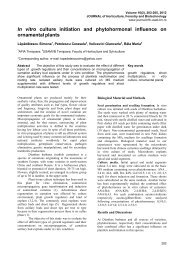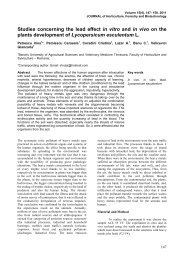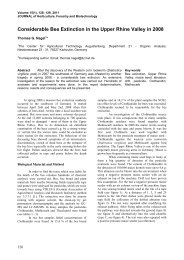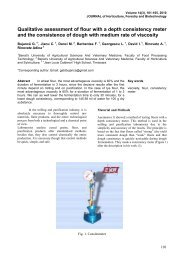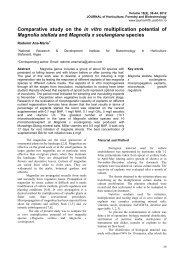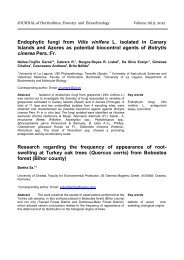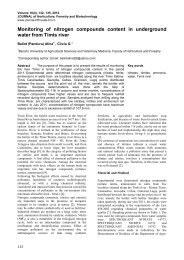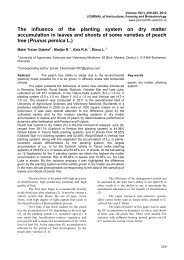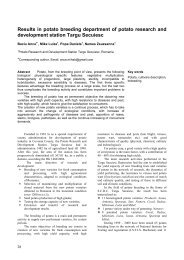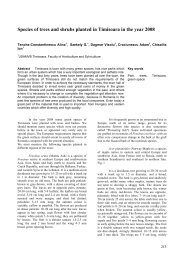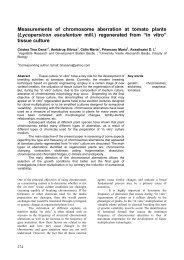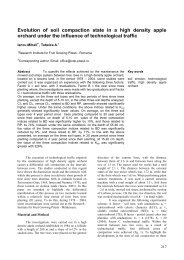Research concerning the composition and organoleptic features
Research concerning the composition and organoleptic features
Research concerning the composition and organoleptic features
Create successful ePaper yourself
Turn your PDF publications into a flip-book with our unique Google optimized e-Paper software.
variants compared to <strong>the</strong> classical system.Study on fungal load of pome fruits, hazardous factor forquality maintaining <strong>and</strong> ensuring <strong>the</strong> consumer safetyȘumălan Renata Maria* 1 , Doncean Ancuța 1 , Șimonea Luciana 1 , Șumălan R. 1 , Camen D 1 .,Beinsan Carmen 1USAMVB Timisoara , Faculty of Horticulture <strong>and</strong> Silviculture*Corresponding author: srenata_maria@yahoo.com; 4soilmicrobiology@gmail.comAbstract Three varieties of apples <strong>and</strong> pears from indigenous <strong>and</strong>external sources have been studied, in regards <strong>the</strong> mesophilic <strong>and</strong>psyhrophilic fungal load. Czapek medium isolation method based on <strong>the</strong>principle of dilution allowed us to determine <strong>the</strong> number of fungi after 5 daysof incubation. The biggest load of mesophilic fungi we determined for Idaredapples from Romania. After <strong>the</strong> macroscopic <strong>and</strong> microscopic examination ofisolated fungi we were identified six species of filamentous fungi Botrytiscinerea, Penicillium expansum, Aspergillus restrictus, Penicilliumchrysogenum, Penicillium solitum, <strong>and</strong> Fusarium equiseti. In <strong>the</strong> category ofstrict mesophilic fungi we have Aspergillus restrictus, Penicilium chrysogenum<strong>and</strong> Fusarium equiseti. The Penicilium expansum, Botritis cinerea <strong>and</strong>Penicillium solitum , we find in both classes of mesophilic <strong>and</strong> psyhrophilicfungi. Calculation of frequency of occurrences on <strong>the</strong> plates for each fungalspecies showed that <strong>the</strong> most bigger frequency was determined for P. solitum(100%) for <strong>the</strong> Golden apples from Romania <strong>and</strong> B. cinerea (80%) for <strong>the</strong>Cure pears from Romania. Application of postharvest measures ofconditioning <strong>and</strong> storage has results in reducing <strong>and</strong> limiting <strong>the</strong> spread offungi, <strong>the</strong>ir importance was established on <strong>the</strong> William pears from Chile.Key wordsfungi spoilage, mesophilic<strong>and</strong> psyhrophilic fungus,apples, pearsThe environmental factors <strong>and</strong> <strong>the</strong>ir influences on mainphysiological processes on apple treesGruia M. 1* , Baciu A. 1 , Cosmulescu Sina 11 University of Craiova, Faculty of Horticulture*Corresponding author. Email:gruiamarius@gmail.comAbstract The influences of environmental factors on <strong>the</strong> cultivars arevery important in <strong>the</strong> orchard. In order to obtain good quality crops it isnecessary to know <strong>the</strong> interaction between plants <strong>and</strong> environmental factors(light, temperature, CO 2 concentration in <strong>the</strong> air, soil humidity, soil fertility,etc.)This paper's aim is to study <strong>the</strong> physiologic reaction (photosyn<strong>the</strong>sis rate,transpiration rate, stomatal conductance of CO 2 ) of few apple cultivars toenvironmental factors (temperature, light). Unfavorable environmentalconditions (temperature, light, too much or too little) cause <strong>the</strong> change in <strong>the</strong>development of physiologic processes.Fuji <strong>and</strong> Pinova are <strong>the</strong> most adapted cultivars for <strong>the</strong> studied area.Key wordsapplecultivars,environmental factors,physiological processes



